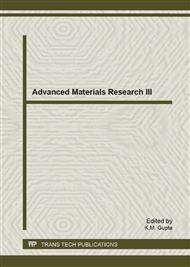p.63
p.68
p.76
p.81
p.86
p.92
p.97
p.102
p.107
Machinability Studies of Peripheral Milling on Pearlitic Cast Iron
Abstract:
Cast Iron with high carbon content is the most commonly used material for machine tool components such as slide guide ways, tables and columns etc, due to its excellent vibration damping characteristics and easy to cast part features. Although it is very easy to cast, cast iron with high carbon content is extremely hard thus making it very difficult to machine. Normally Poly Crystalline Boron Nitride (PCBN) or diamond tipped tools are used for machining these types of Cast Iron to get good surface finish with less tool wear. Unfortunately, cost of these cutting tools is high. Hence it leads to high production cost. In this direction, an attempt has been made to explore the feasibility of machining cast iron with K20 carbide milling cutter with peripheral milling on two different work pieces, one is with heat treated and another one is without heat treated. Tempering process was carried out for heat treatment. Result shows that heat-treated work piece performs well in all aspects compared to non-treated work piece.
Info:
Periodical:
Pages:
86-91
Citation:
Online since:
April 2013
Authors:
Keywords:
Price:
Сopyright:
© 2013 Trans Tech Publications Ltd. All Rights Reserved
Share:
Citation:


